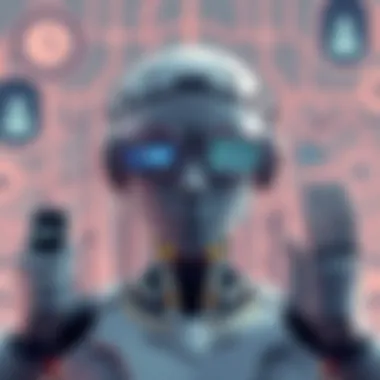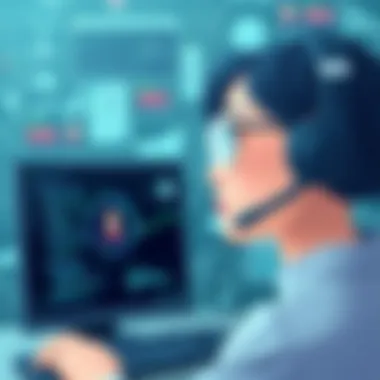Exploring the Rise of AI Selfie Generators and Their Impact


Intro
The arrival of AI selfie generators has stirred the waters in the digital space, generating curiosity and intrigue among tech-savvy individuals and casual users alike. In a day and age where self-image is often meticulously curated, these tools present a compelling intersection of art and science. They allow users to generate self-portraits that embody both personal expression and the power of artificial intelligence. \n\nAI selfie generators are not mere novelty items; they’re reshaping how individuals engage with their own identities digitally. With the proliferation of social media and image-sharing platforms, the capacity for these tools to create visually striking, unique representations of oneself reflects a growing trend towards an augmented self-image. This development goes beyond mere aesthetics, tapping into deeper societal questions about authenticity and the essence of self-representation in the virtual realm. \n
While other facets of this technology exist, such as filters and augmented reality applications, AI selfie generators provide a comprehensive reimagining of personal imagery. They seamlessly blend technology with creative endeavors, providing users with an expansive canvas where imagination meets realism. As we venture deeper into this fascinating topic, we will explore the key features and specifications of these tools, assess their performance compared to competitors, evaluate their design innovations, and weigh the ethical implications they carry. \n\nThrough this exploration, a clearer picture emerges of how AI has turned the tools of self-portraiture into something both revolutionary and contentious, ultimately pushing the boundaries of how we perceive our digital identities.
Prelude to AI Selfie Generators
In a time when selfies have become the currency of self-expression, AI selfie generators are reshaping how people curate and present their identities. This article explores the intricate web woven by advances in artificial intelligence technology and the burgeoning self-portrait culture. Understanding AI selfie generators is pivotal for grasping the broader implications of this phenomenon on society and individual self-representation.
AI selfie generators allow users to produce digital images that reflect their ideal self—often more polished than reality. With these tools at one's fingertips, anyone can snap a photo and transform their image with just a few taps. The significance here lies in how these generators democratize the art of self-representation while also raising concerns about authenticity and privacy.
Definition of AI Selfie Generators
AI selfie generators are digital applications that leverage advanced algorithms—especially machine learning—to create realistic or stylized self-portraits. Unlike traditional photo editing software, these generators utilize neural networks to analyze and modify images extensively. This means a user can upload a simple selfie and, almost instantaneously, receive a transformed version that could incorporate unique artistic styles or enhancements. As a result, the final image may depict a dramatic departure from the original, often embodying an idealized version of the user.
Brief History of Selfie Culture
Selfie culture traces back to the early 2000s when mobile phones with front-facing cameras appeared, but it truly exploded in the 2010s with the rise of platforms like Instagram and Snapchat. The term "selfie" itself entered the mainstream lexicon and became a staple of social media. Each year follows a rush of new trends, from the simple college dorm photo to extravagant travel shots, portraying lives that curated and crafted for digital audiences.
By the time AI entered the picture, there was a foundational landscape already laid out where self-presentation was key. The intersection of selfies and AI technology is not merely a technical advancement; it's a cultural evolution influencing how people see themselves and each other. In today's digital environment, a generation has grown up with a fondness for sharing snapshots that are anything but candid—raising questions about reality and personal image that linger on the heart of human interaction.
"Selfies aren't just images; they're reflections of how we wish to be seen, shaped by the tools we use to create them."
In the coming sections, we will delve deeper into how AI selfie generators function, uncovering the technology that drives them and discussing their various applications in modern society. This granularity not only satisfies the curiosity of tech-savvy readers but also encourages a deeper contemplation of the implications that come with these advancements.
How AI Selfie Generators Work
The operation of AI selfie generators hinges upon specific technologies that allow for incredible manipulation and creation of images. Understanding how these systems function is essential for both users and developers alike, especially as these tools become more prevalent in our digital lives.
At the core of their function, these generators utilize sophisticated algorithms and models, allowing for a seamless blend of creativity and technology. The benefits here range from personalization to enhanced user experience and even inspiring new trends in photography and graphics. Recognizing these elements positions us to appreciate the importance of AI selfie generators not just as tools but as cultural indicators of our evolving relationship with technology.
Technological Underpinnings
Machine Learning Algorithms
Machine learning algorithms serve as the backbone of AI selfie generators, enabling them to analyze vast datasets to learn about patterns in images. This capability reflects one of their most crucial traits—their adaptability. By processing numerous selfies and other images, these algorithms can understand nuances in facial expressions, lighting, and even individual style preferences.
One notable aspect of these algorithms is their ability to improve over time. With each interaction, they gather data that can refine the quality and accuracy of the generated selfies, making them increasingly realistic and personalized. This characteristic ensures that users receive results that resonate with their unique identities. However, there are concerns to consider, like potential biases in the data, which could lead to skewed representations if not addressed.
Neural Networks
Neural networks represent another fundamental element, functioning similarly to the human brain by recognizing patterns and making decisions. Their role in AI selfie generators cannot be overstated, as they help in producing more sophisticated image outputs. One key feature of neural networks is their layer-based architecture, which allows multiple levels of processing, each contributing to the final image output.
This architecture lends neural networks a significant advantage in achieving high-quality, aesthetically pleasing selfies. These networks can create stylized representations with minimal input from the user. However, they don't come without their own set of challenges. Complexity in model training and resource consumption can occasionally lead to slower response times, especially if the network isn’t optimized correctly.
Image Processing Techniques
Deep Learning Approaches
Deep learning approaches provide a profound depth of capability for AI selfie generators, handling complex tasks such as image classification and segmentation. Deep learning, seen by many as the next step in machine learning, allows the generator to produce visually stunning selfies with precise attention to detail.
One of its defining characteristics is its hierarchical structure, which helps the system make sense of intricate data. This capability is particularly beneficial when it comes to managing various elements within an image, ensuring that features like facial details remain sharp and lifelike. However, one downside is that deep learning models can require significant computational power, often limiting their accessibility to those with higher-end hardware.
Style Transfer Methods
Style transfer methods lend a unique flair to the world of AI selfie generation, allowing users to apply artistic styles to their photos. This approach merges content and style from two different images, resulting in creative selfies that can encapsulate a broad spectrum of aesthetics—from classic art to modern designs.
The primary advantage of this technique lies in its ability to enhance creativity. Users can explore various expressions of art and identity through their selfies in a way that was previously impossible.
However, while fascinating, there are challenges. The output can sometimes lean toward the surreal or may not accurately reflect the user's original intentions. This unpredictability can be both a blessing and a curse, depending on what the user aims to achieve.
Features of AI Selfie Generators


Features of AI selfie generators are the linchpins that make these tools engaging and user-friendly. Understanding these features provides insight into how they cater to modern digital behaviors and preferences. Users today not only demand high-quality self-portraits but also crave personalization in their expressions. This section explores two core features: customization options and user experience design, dissecting how each brings unique value to users.
Customization Options
Customization options are pivotal in setting apart AI selfie generators from traditional photography techniques. The ability to tailor selfies with various filters and backgrounds has sparked a wave of creativity among users.
Filters and Effects
Filters and effects take center stage as a major attraction in AI selfie generators. Users can experiment with a wide range of filters that alter colors, contrasts, and overall aesthetics, effectively transforming an ordinary selfie into a work of art. One standout characteristic of filters is their capability to cater to different moods—be it a vibrant, sunny afternoon or a more moody, dramatic evening.
The key reason filters are so popular is their ease of use. Anyone, regardless of their photography experience, can instantly enhance their images with just a few clicks. This democratization of creativity is a game-changer in the way individuals express themselves online. However, while the immediate impact of these filters is often positive, there is a downside; over-reliance on them can lead to unrealistic expectations about beauty and self-representation. Consequently, users must strike a balance between creativity and authenticity.
Background Alterations
Background alterations add another layer of customization that appeals to many users. Whether it’s a serene beach or a bustling cityscape, the ability to change backgrounds can dramatically affect the narrative surrounding a selfie. The primary characteristic that makes this option appealing is the power it grants users to transport themselves into different settings without leaving their homes.
One unique feature of background alterations is the use of smart algorithms that can seamlessly integrate subjects with their new environments. This capability allows for a stunning visual appeal that can enhance storytelling in images. However, the flipside is that users might inadvertently misrepresent their real-life settings, leading to a disconnect between online personas and actual reality.
User Experience Design
User experience design plays a crucial role in how effectively individuals interact with AI selfie generators. This aspect shapes not only usability but also the overall enjoyment of the user as they create.
Interface Layout
The interface layout of these applications greatly influences user engagement. A well-conceived layout allows for intuitive navigation, enabling users to focus on creativity rather than fumbling through complicated menus. Prominent features are typically easy to locate, making the process of enhancing self-shots quick and enjoyable.
One key characteristic of effective interface layouts is their responsiveness. Interfaces that adapt smoothly to different devices—be it a smartphone or tablet—ensure that users can create stunning selfies on the go. However, it’s important to note that overly complex interfaces can lead to frustrations. Users may abandon an app that does not present features clearly, underscoring the necessity for clean and efficient design.
Accessibility Features
Accessibility features are vital for inclusivity in AI selfie generators. These features ensure that individuals of all abilities can enjoy the creative process. Elements such as voice commands, text-to-speech functions, and adjustable color contrasts significantly enhance usability for those with disabilities.
The main takeaway for accessibility features is that they open doors for everyone, expanding the user base and fostering a more diverse online community. The incorporation of such enhancements not only reflects a commitment to inclusivity but also results in a richer user experience. However, developing these features may require additional resources and could complicate the design process, demanding a thoughtful approach to implementation.
In summary, the features of AI selfie generators—including customization options and user experience design—are essential in shaping how users present themselves online. Keeping these factors in mind is critical for anyone involved in the further development and marketing of these technologies.
Practical Applications
In the evolving realm of technology, the practical application of AI selfie generators emerges as a significant narrative. The way people share their lives on social media has morphed drastically with these tools, as they cater to both aesthetics and functionality. For individuals keen on crafting their digital personas, these applications allow users to curate their visual representation in real-time, thus enhancing personal branding while supporting various platforms.
Social Media Trends
Influencer Marketing
Influencer marketing leverages the power of relatability and reach. It is an effective way to tap into niche audiences, as tiny influencers or large personalities alike utilize AI-generated selfies to boost engagement. On platforms such as Instagram and TikTok, influencers can create content that effortlessly aligns with brand aesthetics, drawing attention and potentially increasing follower counts for both themselves and the brands.
A key characteristic lies in the visual appeal, making it a favorable choice for marketing strategies. Utilizing AI selfie generators offers influencers the ability to experiment with diverse styles—ensuring their visual content remains fresh and engaging. However, reliance on these technologies does pose a risk:
- Over-saturation of curated content can make the digital space feel disingenuous.
- Authenticity may be questioned, challenging the influencer's credibility in the eyes of their audience.
Incorporating AI-generated selfies aids not just in branding, but also creates moments that resonate with followers. These tools enable influencers to maintain a balance between creative flare and audience expectation.
Consumer Engagement Strategies
Consumer engagement strategies greatly benefit from the personalization options provided by AI selfie generators. With the ability to create diverse images that reflect customer interests and preferences, brands deepen their connection to audiences.
The main characteristic of tailored content elevates user experiences, making interactions more compelling. Brands leveraging these strategies can significantly enhance loyalty and satisfaction. Unique features such as customizable filters and effects allow users to see their “ideal selves,” encouraging them to share these images, which in turn increases organic reach.
Some advantages are:
- Higher interaction rates as consumers feel more represented.
- Shareable content that drives virality, potentially amplifying brand exposure.
On the flip side, there are concerns related to over-reliance on technology, potentially desensitizing genuine experiences and creating expectations that can't always be met in reality. Balancing engagement strategies with authentic brand representation becomes crucial as brands navigate this technology-enhanced landscape.


Entertainment and Gaming
Virtual Avatars
Virtual avatars serve as a fascinating offshoot of AI selfie generators, creating personalized digital identities for users in gaming and online communities. These avatars often reflect individual styles, interests, and even insecurities, inviting users to explore unique expressions without the constraints of reality.
The interactivity of avatars elevates the user experience, making it a quintessential feature in modern gaming. For instance, platforms like Roblox and Fortnite are designed with this personalization in mind. The unique aspect of virtual avatars is the transformative potential they possess:
- They allow users to escape and explore new realities.
- Offer new ways to connect with peers in a shared virtual space.
However, there may be drawbacks as people might conflate their avatars with their identities, leading to potential issues in self-image and comparison.
Augmented Reality Experiences
Let’s discuss augmented reality experiences, which allow users to blend their physical and digital worlds through enhanced visual overlays. The introduction of AI selfie generators into AR circuitry opens doors to limitless creativity within user interactions.
AR enables users to see themselves in different environments with personalized edits at their fingertips, a benefit for both content creation and enjoyment. The key characteristic here is the immersive experience that goes beyond traditional photo editing. Users can have fun while exploring imaginative settings, all facilitated by accessible technology.
Some notable features include:
- Real-time feedback on how the changes look on the user’s selfie.
- Enhance opportunities for virtual social interactions in, say, Tinder, using AR filters for more dynamic engagement.
Conversely, one must tread carefully here, as excessive reliance on AR experiences could further blur the lines between reality and digital facades—raising valid questions about authenticity in our social exchanges.
The growing integration of AI selfie generators in various practical applications highlights their multifaceted nature.
In summary, the practical applications of AI selfie generators touch upon vital elements of social media dynamics and entertainment trends. Their influence is poised to evolve as technology continues to advance, particularly regarding personal identity in the digital sphere.
Market Overview of AI Selfie Generators
The landscape of AI selfie generators presents a fascinating intersection of technology and consumer behavior. With the rapid rise of digital sharing, particularly through social media platforms, understanding the market dynamics of these products helps us grasp their impact on our visual culture. This section aims to shed light on both established brands and emerging players, alongside shedding some light on user adoption trends that reflect shifting demographics and preferences in this realm.
Leading Providers
Comparison of Major Brands
Leading providers in the AI selfie generator market showcase varying capabilities and unique offerings. Companies like Lensa and Remini stand at the forefront, known for their polished interfaces and extensive customization options. For instance, Lensa has carved a niche for itself as a go-to app offering a blend of photo editing features and AI-powered beautification tools. Their standout enhancement algorithms draw users who seek professional-quality selfies without the need for extensive editing skills.
Conversely, Remini shines in low-quality image upscaling, transforming old photos into high-definition marvels. Notably, Remini utilizes deep learning to breathe new life into faded memories, which could be an attractive feature for nostalgia-seekers. By looking at these brands, it's evident that users often gravitate towards those who deliver not only personalized experiences but also continual updates and innovations to keep pace with the fast-evolving tech landscape.
Emerging Startups
The startup scene within the AI selfie generator space is a hotbed for innovative ideas and fresh functionalities. New entrants like Photohance and AI Portraits highlight how nimble startups can introduce disruptive features that capture user interest. Photohance focuses on creating artistic filters that allow users to transform selfies into artwork, immediately appealing to the creativity-driven audience. Its intuitive approach enhances user engagement, thus increasing its popularity amongst a younger demographic.
AI Portraits, on the other hand, leverages neural networks to generate stylized, imaginative renditions of user images. This app has gained traction, particularly within niche art communities, as users experiment with different artistic styles, pulling inspiration from classical artworks. These startups, while less established than their counterparts, demonstrate the agility to adapt quickly, appealing to users seeking novelty and unique, shareable content.
User Adoption Rates
The trajectory of user adoption rates for AI selfie generators reveals insightful patterns concerning who is engaging with these technologies and how. Knowing the demographics can help predict future growth and tailor offerings accordingly.
Demographics of Users
A closer look into the demographics indicates that younger generations dominate the user base. Data suggest that individuals aged 18 to 34 are more likely to experiment with AI selfie generators, leveraging them to enhance personal branding as they navigate Job markets and instances of self-presentation on social media. Millennials and Gen Z see these tools not merely as utilities but as essential elements in curating their digital identity. Their propensity towards image-sharing platforms like Instagram, TikTok, and Snapchat drives a cultural practice where selfies now reflect not just personal experiences but also trends and societal ideals.
Trends in User Growth
Recent trends point to an increasing adoption rate of AI selfie generators across broader age spectrums and regions. Recent surveys indicate that over 60% of users report a willingness to try these tools, driven by the rising familiarity with AI technology. The intersection of social media integration and user-friendly interfaces lays a rich groundwork for sustainable and broad user growth.
Moreover, the expansion of mobile technology to varied global markets indicates that individuals in developing regions are also inclined to leverage these technologies for self-expression. Offering an accessible entry point to professional-quality photography, AI selfie generators have started to feature distinctly in global self-representation discussions.
In summary, navigating the market of AI selfie generators unveils not just the competitive offerings but also the users who are steering these trends. By understanding the brands leading the charge and the demographic leanings that embrace these tools, we inch closer to appreciating the comprehensive landscape of AI-driven self-portraits in the digital age.
Implications for Privacy and Ethics


As we navigate the brave new world of AI selfie generators, the implications for privacy and ethics stand out like a sore thumb. The transformation of personal identity in digital spaces comes with heavy baggage; understanding this landscape requires us to dive into the thick of data practices and image authenticity. The benefits of these technologies are compelling, but they walk hand-in-hand with significant concerns that merit serious attention.
Data Collection Practices
User Consent
When we talk about user consent in the realm of AI selfie generators, it’s really all about what’s between us and our images. Users often don’t give a second thought to the fine print when using these tools, yet the agreements they sign can have far-reaching consequences. A key characteristic of user consent is transparency: ideally, it should be clear and straightforward, presenting information about what data is collected and how it’s used.
However, this isn’t always the case. Often, these consent forms are laced with legal jargon, leaving users scratching their heads. One unique feature of user consent is its direct impact on user trust. If individuals feel their consent is valid and informed, they are likely to engage more fully with the service. But there's a caveat: when consent is misunderstood or lacked altogether, users might unknowingly relinquish control over their personal image. This ambiguity can pose serious disadvantages, like unauthorized use of images or exposure to harmful marketing practices.
Data Security Concerns
Data security concerns can strike fear in anyone’s heart, especially as more personal content flows through the digital ether. One of the main aspects here is safeguarding the sensitive information tied to our selfies. A striking characteristic of data security concerns is the vulnerability of user data to breaches, which can lead to identity theft or other nefarious acts.
In this article, we note that ensuring effective data security is not just a trendy topic; it’s a pressing necessity for maintaining user confidence. A unique feature of these security measures is that they often involve encryption protocols and regular audits to guard against breaches. However, the truly beneficial aspects hinge on constant updating and vigilance. Conversely, the disadvantage is that no matter how secure a system is marketed, the reality is that vulnerabilities still exist, leaving users in a precarious position.
Image Authenticity Issues
Misrepresentation Risks
Misrepresentation risks balloon when you throw AI into the mix. The public might embrace AI selfies as creative expression, but they also blur the line between reality and deception. The characteristic of misrepresentation risks here is that they raise profound questions about authenticity in self-image.
This article highlights that misrepresentation can lead to social and psychological issues, where individuals may feel pressured to match unrealistic ideals that AI can create. The unique feature about these risks is that while AI enables creativity and fun, it simultaneously fosters an environment where users might project distorted versions of themselves. This clash creates a double-edged sword; potential benefits come wrapped in levels of deception that can harm self-esteem and societal perceptions.
Deepfake Technology
The rise of deepfake technology brings various ethical quandaries to the fore. This technology offers an intriguing opportunity to play with our images but raises alarms about authenticity. A fundamental characteristic of deepfake technology is its ability to generate hyper-realistic alterations to videos and images that can trick even the sharpest eyes.
In this article’s exploration, we find that deepfakes can serve innocuous purposes, such as enhancing creative content for movies or virtual reality. However, the unnerving potential for misuse in the form of creating defamatory content is undeniable. What makes deepfake technology especially chilling is its ease of access; enhanced software can turn anyone into a digital sculptor with minimal effort. The advantages range from artistic freedom to educational tools, but the disadvantages are substantial, posing threats to personal reputation and security.
"As we step forward into the world of AI selfie generators, the balance between creative freedom and ethical responsibility becomes not just a topic for conversation but a call for action."
Future Trends in AI Selfie Generation
The realm of AI selfie generators is not just a fleeting trend in the digital world; it’s the tip of an iceberg of evolving technologies that are about to shape the way we understand self-representation in the digital age. As advancements continue, it’s crucial to grasp the future trends emerging in this landscape and their implications for both technology and society. This section explores the crucial elements and benefits surrounding future developments in AI selfie generation, providing a window into how these developments will influence user experience and cultural norms.
Advancements in AI Technology
Improved Algorithms
At the forefront of AI development is the improvement of algorithms. These algorithms are becoming increasingly sophisticated, enhancing the quality and efficiency of selfie generation. One significant characteristic of improved algorithms is their ability to learn from vast datasets. This capability allows them to fine-tune and adapt to the unique preferences and styles of individual users, creating a more personalized experience.
The most popular choices among developers lean towards Generative Adversarial Networks (GANs), which blend a pair of neural networks in a sort of digital tug-of-war, leading to more realistic selfies. The unique feature of these improved algorithms is their capacity for producing high-quality images with unprecedented speed.
However, they also pose challenges—such as the need for robust datasets to prevent biases, which can inadvertently seep into the models. In addition, the computational power required can limit accessibility for smaller developers, constraining innovation in this space.
Integration with Other Tech
Integration with other technologies is a pivotal trend that enhances the functionalities of AI selfie generators. With the rise of Augmented Reality (AR) and Virtual Reality (VR), blending AI selfie generation with these technologies could create interactive experiences that were once part of science fiction. This integration stands out due to its ability to engage users fully, offering immersive experiences that keep users hooked.
A unique feature lies in how seamless the integration can be. For instance, using facial recognition technology and real-time image processing, users can modify their selfies with dynamic effects that react to their emotions or actions. While such features provide imaginative possibilities, they can also raise concerns about privacy and consent, as user data is harnessed in real time for enhancement.
Societal Impact
Cultural Shifts
Cultural shifts resulting from AI selfie generation are profound. As these tools become embedded in daily life, the way society views self-image and identity continues to transform. One defining characteristic of this trend is the democratization of self-representation. No longer confined to professional photographers, anyone can now create polished images that reflect their persona, reshaping social norms.
This shift is beneficial as it encourages creativity and self-exploration among users. However, it also raises questions about the pressures of conforming to digitally enhanced ideals of beauty and success. Societal views on authenticity may struggle against the backdrop of manipulated imagery, which can potentially lead to psychological implications regarding self-worth and body image.
New Standards of Beauty
Finally, the emergence of AI selfie generation has ushered in new standards of beauty, often dictated by social media and the influencers who use these tools. One notable characteristic of this development is the increasingly narrow perception of beauty—idealized features proliferate through platforms that propagate enhanced profiles to masses.
This phenomenon offers appealing moments of self-presentation, allowing individuals to showcase their idealized selves. Nevertheless, the flip side is reputational risks and potential mental health strains, as individuals may chase unattainable aesthetics propagated online. The constant comparison driven by AI-generated content can foster a culture that values appearance over authenticity, leading to an environment where psychological distress might become commonplace.
"As AI reshapes how we generate and perceive selfies, the quest for authenticity and self-acceptance continues to gain complexity across cultures."
The future of AI selfie generation lays a fascinating framework that merges technological innovation with significant societal implications, sparking conversations about identity, representation, and self-expression. As we navigate this evolving landscape, its developments will highlight the interplay between technology and the human experience.



